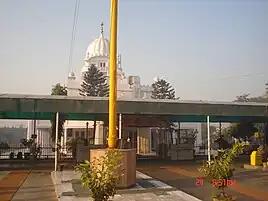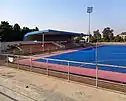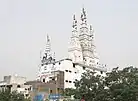Ludhiana
Ludhiana (Punjabi pronunciation: [lʊdiˈɑːnə] ) is the most populous and the largest city in the Indian state of Punjab.[9] The city has an estimated population of 1,618,879 as of the 2011 census and distributed over 310 km2 (120 sq mi),[6] making Ludhiana the most densely populated urban centre in the state.[10] It is a major industrial center of Northern India, referred to as "India's Manchester" by the BBC.[11] It is also known as the commercial capital of Punjab.[9][12][13]
Ludhiana | |
|---|---|
From top, left to right: Maharaja Ranjit Singh War Museum, Gurdwara Manji Sahib, PAU Stadium, Shri Durga Mata Mandir, Ludhiana Skyline, Guru Nanak Stadium | |
 Ludhiana Interactive map of Ludhiana  Ludhiana Ludhiana (India) | |
| Coordinates: 30.91°N 75.85°E | |
| Country | |
| State | Punjab |
| District | Ludhiana |
| Tehsil | Ludhiana West Ludhiana East |
| Founded by | Lodi dynasty |
| Named for | Lodi (Pashtun tribe) |
| Government | |
| • Type | Mayor–Council |
| • Body | Ludhiana Municipal Corporation |
| • Deputy Commissioner | Surabhi Malik I.A.S[2] |
| • Mayor | Balkar Sandhu[3] |
| Area | |
| • Total | 310 km2 (120 sq mi) |
| • Rank | 1st in Punjab |
| Elevation | 247 m (810 ft) |
| Population | |
| • Total | 1,618,879 |
| • Rank | 22nd in India, 1st in Punjab |
| • Density | 5,200/km2 (14,000/sq mi) |
| Demonym | Ludhianvi |
| Time zone | UTC+5:30 (IST) |
| PIN | Multiple 141001-141016 |
| Telephone code | 0161 |
| Vehicle registration | PB-10, PB-91 |
| HDI (2018) | |
| Website | www |
It stands on the old bank of Sutlej River, that is now 13 kilometres (8.1 mi) to the south of its present course. The Union Ministry of Housing and Urban Affairs has placed Ludhiana on the 48th position among the top 100 smart cities,[14] and the city has been ranked as one of the easiest cities in India for business according to the World Bank.
History
Ludhiana was founded in 1480 by members of the ruling Lodhi dynasty of the Delhi Sultanate.[15] The ruling sultan, Sikandar Lodhi, dispatched two ruling chiefs, Yusuf Khan and Nihad Khan, to re-assert Lodhi control. The two men camped at the site of present Ludhiana, which was then a village called Mir Hota. Yusuf Khan crossed the Sutlej and established Sultanpur, while Nihad Khan founded Ludhiana on the site of Mir Hota.
The name was originally Lodhi-ana", meaning "Lodhi town", which has since shifted from "Lodiana" to the present form of Ludhiana.[16] The Lodhi Fort, or "Purana Qila", is the only surviving structure in the city from this period; located in the neighbourhood of Fatehgarh, it was well-maintained under Ranjit Singh and the British after him, but then fell into disrepair. It was declared a state-protected monument in December 2013.[17]
The Semi Centennial Celebration of the American Presbyterian Lodiana Mission was held in Ludhiana from 3–7 December 1884.[18]
Ludhiana's Old City includes landmarks like the Lodhi Fort, Daresi Grounds, The Clock Tower, & Sood Family Haveli.
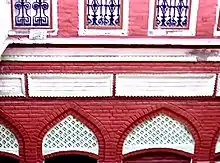
Geography
Ludhiana is located at 30.9°N 75.85°E.[19] It has an average elevation of 244 metres (801 ft). Ludhiana City, to its residents, consists of the Old City and the New City. The new city primarily consists of the Civil Lines area which was historically known as the residential and official quarters of the colonial British encampment.
The land dips steeply to the north and the west where, before 1785, the river Sutlej ran.
The Old Fort was at the banks of the Sutlej (and now houses the College of Textile Engineering). Legend has it that a tunnel connects it to the fort in Phillaur– although why this should be is debatable, as the Sutlej was the traditional dividing line between the principalities, often occupied by enemy forces (see History section).
The ground is of yellow sandstone and granite, forming small hillocks, plateaus and dips.
The tree of largest natural extraction was the kikar, or Acacia Indica, but has been supplanted by the eucalyptus, transplanted from rural Australia in the late 1950s by the Chief Minister Partap Singh Kairon.
Gulmohars and jacarandas were planted by the British along the avenues of Civil Lines, as were other flowering trees, while the Old City contains almost no vegetation or parks, except for a few isolated pipal trees, holy to the Hindus, as it is supposed to be the abode of Lord Shiva.
Climate
Ludhiana features a relatively dry monsoon-influenced humid subtropical climate (Cwa) under the Köppen climate classification, although bordering on a hot semi-arid climate (BSh), with three defined seasons; summer, monsoon and winter. Ludhiana on an average sees roughly 809.3 millimetres (31.86 in) of precipitation annually. The official weather station for the city is in the compound of the Civil Surgeon's Office to the west of Ludhiana. Weather records here date back to 1 August 1868.
Ludhiana has one of the worst air pollution problems in India since 2011, with particulate matter being over six times the World Health Organization recommended standard, making it the 13th most polluted city in the world.[20][21] Industrial water pollution is also of significant concern in portions of Ludhiana, notably along the Budha Dariya.[22]
| Month | Jan | Feb | Mar | Apr | May | Jun | Jul | Aug | Sep | Oct | Nov | Dec | Year |
|---|---|---|---|---|---|---|---|---|---|---|---|---|---|
| Record high °C (°F) | 29.0 (84.2) |
30.4 (86.7) |
41.1 (106.0) |
46.1 (115.0) |
48.3 (118.9) |
47.9 (118.2) |
47.8 (118.0) |
44.4 (111.9) |
41.7 (107.1) |
40.0 (104.0) |
35.8 (96.4) |
29.4 (84.9) |
48.3 (118.9) |
| Mean maximum °C (°F) | 23.8 (74.8) |
26.9 (80.4) |
32.6 (90.7) |
40.7 (105.3) |
43.8 (110.8) |
43.5 (110.3) |
37.9 (100.2) |
35.8 (96.4) |
35.6 (96.1) |
34.7 (94.5) |
30.7 (87.3) |
25.1 (77.2) |
44.8 (112.6) |
| Average high °C (°F) | 18.6 (65.5) |
22.2 (72.0) |
27.3 (81.1) |
35.0 (95.0) |
38.9 (102.0) |
37.9 (100.2) |
34.0 (93.2) |
33.1 (91.6) |
33.0 (91.4) |
31.9 (89.4) |
27.3 (81.1) |
21.6 (70.9) |
30.1 (86.2) |
| Average low °C (°F) | 5.6 (42.1) |
8.2 (46.8) |
12.3 (54.1) |
17.7 (63.9) |
22.9 (73.2) |
25.3 (77.5) |
25.8 (78.4) |
25.1 (77.2) |
22.8 (73.0) |
16.5 (61.7) |
10.7 (51.3) |
6.5 (43.7) |
16.6 (61.9) |
| Mean minimum °C (°F) | 1.2 (34.2) |
3.4 (38.1) |
7.3 (45.1) |
12.0 (53.6) |
17.6 (63.7) |
20.5 (68.9) |
22.0 (71.6) |
21.7 (71.1) |
18.8 (65.8) |
12.6 (54.7) |
6.0 (42.8) |
2.5 (36.5) |
0.8 (33.4) |
| Record low °C (°F) | −2.2 (28.0) |
−1.1 (30.0) |
1.4 (34.5) |
7.1 (44.8) |
11.7 (53.1) |
18.0 (64.4) |
17.4 (63.3) |
18.0 (64.4) |
15.2 (59.4) |
9.4 (48.9) |
0.3 (32.5) |
−1.1 (30.0) |
−2.2 (28.0) |
| Average rainfall mm (inches) | 28.3 (1.11) |
37.0 (1.46) |
29.9 (1.18) |
17.3 (0.68) |
22.3 (0.88) |
69.2 (2.72) |
215.0 (8.46) |
205.2 (8.08) |
146.0 (5.75) |
19.8 (0.78) |
4.3 (0.17) |
15.1 (0.59) |
809.3 (31.86) |
| Average rainy days | 2.2 | 2.7 | 2.4 | 1.7 | 2.0 | 4.3 | 8.4 | 8.6 | 5.0 | 1.0 | 0.6 | 1.0 | 39.9 |
| Average relative humidity (%) (at 17:30 IST) | 63 | 54 | 46 | 25 | 23 | 41 | 67 | 73 | 65 | 49 | 49 | 63 | 51 |
| Average dew point °C (°F) | 8 (46) |
12 (54) |
15 (59) |
16 (61) |
19 (66) |
23 (73) |
26 (79) |
26 (79) |
24 (75) |
19 (66) |
13 (55) |
10 (50) |
18 (64) |
| Average ultraviolet index | 4 | 5 | 7 | 8 | 9 | 9 | 8 | 7 | 7 | 6 | 5 | 4 | 7 |
| Source 1: India Meteorological Department[23][24]Time and Date (dewpoints, 2005-2015)[25] | |||||||||||||
| Source 2: Weather Atlas[26] | |||||||||||||
| Climate data for Ludhiana (Punjab Agricultural University) 1981–2010 normals, extremes 1966–2011 | |||||||||||||
|---|---|---|---|---|---|---|---|---|---|---|---|---|---|
| Month | Jan | Feb | Mar | Apr | May | Jun | Jul | Aug | Sep | Oct | Nov | Dec | Year |
| Record high °C (°F) | 29.2 (84.6) |
30.0 (86.0) |
37.0 (98.6) |
44.0 (111.2) |
46.6 (115.9) |
46.0 (114.8) |
43.6 (110.5) |
40.0 (104.0) |
38.2 (100.8) |
37.6 (99.7) |
35.4 (95.7) |
27.2 (81.0) |
46.6 (115.9) |
| Average high °C (°F) | 18.1 (64.6) |
21.1 (70.0) |
26.6 (79.9) |
34.5 (94.1) |
38.4 (101.1) |
38.2 (100.8) |
34.4 (93.9) |
33.5 (92.3) |
33.5 (92.3) |
31.9 (89.4) |
26.8 (80.2) |
21.0 (69.8) |
29.8 (85.6) |
| Average low °C (°F) | 5.7 (42.3) |
7.8 (46.0) |
12.4 (54.3) |
17.4 (63.3) |
22.8 (73.0) |
25.9 (78.6) |
26.3 (79.3) |
25.8 (78.4) |
23.2 (73.8) |
16.7 (62.1) |
10.9 (51.6) |
6.7 (44.1) |
16.8 (62.2) |
| Record low °C (°F) | −1.6 (29.1) |
0.0 (32.0) |
2.1 (35.8) |
9.0 (48.2) |
12.0 (53.6) |
18.0 (64.4) |
20.5 (68.9) |
20.6 (69.1) |
14.5 (58.1) |
8.4 (47.1) |
4.3 (39.7) |
0.2 (32.4) |
−1.6 (29.1) |
| Average rainfall mm (inches) | 28.0 (1.10) |
30.4 (1.20) |
24.2 (0.95) |
21.9 (0.86) |
26.5 (1.04) |
68.6 (2.70) |
221.4 (8.72) |
195.3 (7.69) |
101.6 (4.00) |
12.9 (0.51) |
6.9 (0.27) |
14.1 (0.56) |
751.7 (29.59) |
| Average rainy days | 2.3 | 2.6 | 2.3 | 2.3 | 2.3 | 4.2 | 8.4 | 8.0 | 4.3 | 0.9 | 0.5 | 1.1 | 39.0 |
| Average relative humidity (%) (at 17:30 IST) | 67 | 62 | 52 | 30 | 28 | 42 | 66 | 72 | 63 | 49 | 51 | 62 | 54 |
| Source: India Meteorological Department[27][28] | |||||||||||||
Demographics
As per the 2011 census, Ludhiana had a population of 2,618,879.[7] The literacy rate was 86.50 per cent, and the population consisted of 950,123 males and 743,530 females.[29][7]
Religion
With around 66% adherents according to 2011 Indian Census, Hinduism is the predominant religion of Ludhiana, followed by Sikhism with 29% of the population. Islam is followed by 2.8% and Christianity by less than 1%.[31]
Prior to India's partition, Ludhiana had a population of 111,639 with Muslims being the majority with 62.9%.[32]: 32 The Hindus were 31.1% and Sikhs 4.7%.[32]: 32 It changed post-partition with a drastic reduction in Muslim percentage and simultaneous increase in Hindu and Sikh population, owing to migration of people between West and East Punjab.[33]
| Religious group |
1891[34]: 68 | 1901[35]: 44 | 1911[36]: 20 | 1921[37]: 23 | 1931[38]: 26 | 1941[32]: 32 | 2011[31] | |||||||
|---|---|---|---|---|---|---|---|---|---|---|---|---|---|---|
| Pop. | % | Pop. | % | Pop. | % | Pop. | % | Pop. | % | Pop. | % | Pop. | % | |
| Islam |
30,257 | 65.3% | 31,472 | 64.69% | 27,197 | 61.57% | 30,921 | 59.6% | 42,981 | 62.67% | 70,182 | 62.87% | 45,473 | 2.81% |
| Hinduism |
13,871 | 29.94% | 15,249 | 31.34% | 14,079 | 31.87% | 17,092 | 32.95% | 20,758[lower-alpha 2] | 30.27% | 34,704[lower-alpha 2] | 31.09% | 1,067,744 | 65.96% |
| Sikhism |
1,065 | 2.3% | 756 | 1.55% | 1,684 | 3.81% | 2,550 | 4.92% | 3,445 | 5.02% | 5,273 | 4.72% | 465,393 | 28.75% |
| Jainism |
813 | 1.75% | 804 | 1.65% | 658 | 1.49% | 667 | 1.29% | 344 | 0.5% | 605 | 0.54% | 16,941 | 1.05% |
| Christianity |
328 | 0.71% | 368 | 0.76% | 552 | 1.25% | 631 | 0% | 1,049 | 1.53% | 596 | 0.53% | 11,044 | 0.68% |
| Zoroastrianism |
0 | 0% | 0 | 0% | 0 | 0% | 19 | 0.04% | 5 | 0.01% | — | — | — | — |
| Buddhism |
0 | 0% | 0 | 0% | 0 | 0% | 0 | 0% | 4 | 0.01% | — | — | 1,700 | 0.11% |
| Others | 0 | 0% | 0 | 0% | 0 | 0% | 0 | 0% | 0 | 0% | 279 | 0.25% | 10,584 | 0.65% |
| Total population | 46,334 | 100% | 48,649 | 100% | 44,170 | 100% | 51,880 | 100% | 68,586 | 100% | 111,639 | 100% | 1,618,879 | 100% |
Language
At the time of the 2011 census, It was found that Ludhiana city have a population of 1,618,879 persons. About 1,453,829 (89.80%) of the population spoke Punjabi as their mother tongue, 157,031 (9.7%) of the population spoke Hindi as their mother tongue and 0.5% spokes other Indian languages.[39]
Administration
Ludhiana Municipal Corporation is the urban local civic body in the city.[40]
Politics
The city is part of the Ludhiana (Lok Sabha constituency). The assembly constituencies in the city are:
| Constituency number |
Constituency name |
Reserved for (SC/None) |
Electors (2017)[41][42] |
|---|---|---|---|
| 60 | Ludhiana East | None | 182,228 |
| 61 | Ludhiana South | None | 149,582 |
| 62 | Atam Nagar | None | 157,578 |
| 63 | Ludhiana Central | None | 147,646 |
| 64 | Ludhiana West | None | 176,915 |
| 65 | Ludhiana North | None | 181,931 |
Economy
The World Bank ranked Ludhiana as the city in India with the best business environment in 2009 and 2013.[43] The riches are brought mostly by small-scale industrial units,[44] which produce industrial goods, machine parts, auto parts, household appliances, hosiery, apparel, and garments. Ludhiana is Asia's largest hub for bicycle manufacturing and produces more than 50% of India's bicycle production each year. Ludhiana produces 60% of India's tractor parts and a large portion of auto and two-wheeler parts. Many parts used in German cars such as Mercedes and BMW are exclusively produced in Ludhiana to satisfy the world requirement. It is one of the largest manufacturer of domestic sewing machines. Hand tools and industrial equipment are other specialties. Ludhiana contribute most to Punjab than any other city.
The apparel industry of Ludhiana, popularly known as Ludhiana hosiery industry provides employment to numerous people[45] and produces India's largest share of winter clothing. It is especially known for its woollen sweaters and cotton T-shirts with the majority of India's woollen clothing brands being based here. Ludhiana is also famous for its industry of shawls and stoles and satisfies the demand of major domestic and international brands. As a result of its dominance in the textile industry it is often dubbed as the Manchester of India.[46] Ludhiana is now sourcing production to major corporate brands all over India. Cloths manufactured here sell in big brand showrooms. Ludhiana also has a growing IT sector with multiple software services and product companies having development centers in the city. In April 2021, BizMerlinHR, a HR management software firm with development center in Ludhiana was awarded Cool Vendor in HCM for 2021 by industry analyst Gartner.[47]
Ludhiana was home to the Ludhiana Stock Exchange Association. LSE was situated on NH95 (Chandigarh-Ferozepur Highway) in Feroze Gandhi market near Mini Secretariat Ludhiana. The association is now defunct.
Attractions
Sports
Guru Nanak Stadium in Ludhiana hosts a number of sporting events including athletics, football, badminton, basketball, gymnastics, handball, kabaddi, table tennis, volleyball, as well as other indoor games.[48]
- Kabaddi
Kabaddi world cup finals have been played twice in Guru Nanak Stadium Ludhiana.[49] The stadium often hosts high-profile Kabaddi matches.
- Football
Various competitions like finals of National Games Football Matches (2001) and I-League matches of clubs like Minerva Punjab FC (now RoundGlass Punjab Football Club) have been played in Guru Nanak Stadium.[50]
Kila Raipur Sports Festival
Kila Raipur Sports Festival, popularly known as Rural Olympics Games, is held annually in Kila Raipur, near Ludhiana. Competitions are held for rural sports, including gatka, bullock cart races, trolley races, kabaddi, loading unloading trucks and acrobatics.[51]
Skating
A skating rink is situated in Leisure Valley, Sarabha Nagar.[52]
Places of interest
- Alamgir
- Doraha
- Jagraon
- Katana Sahib
- Khanna
- Kila Raipur
- Machhiwara
- Mullanpur Dakha
- Nanaksar
- Payal
- Serai Lashkari Khan
- Sidhwanbet
- Rose Garden
- Rakh Bagh
- Sudhar
- Sri Bhaini Sahib
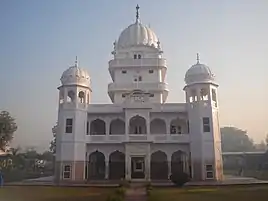
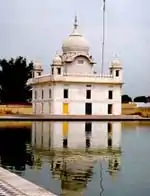 Nanaksar Kaleran
Nanaksar Kaleran Pre independence architect Khanna
Pre independence architect Khanna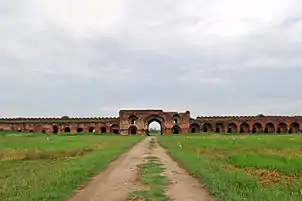
 Ludhiana Zoo
Ludhiana Zoo
Transportation
Ludhiana is well connected by road and rail as Ludhiana railway station is on the main Delhi-Amritsar route, and is an important railway junction with lines going to Jalandhar, Ferozepur, Dhuri, and Delhi. The city is very well connected with daily or weekly trains to most places in India including the major cities of Jammu, Amritsar, Jalandhar, Patiala, Pathankot, Kanpur, Jaipur, Ajmer, Chandigarh, Ambala, Panipat, Delhi, Pune, Mumbai, Indore, Bhopal, Lucknow, Ahmadabad, Nagpur, Ayodhya, Nanded, Patna, and Kolkata. For administrative reasons the station is under Ferozepur Railway Division. The railway line between Ludhiana and Chandigarh opened in 2013. The government has even passed a dedicated freight track between Ludhiana and Kolkata. [53]
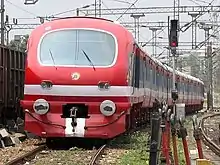
Road

Ludhiana is connected with other cities of Punjab and also with other states by bus service. Major national highways NH 44, NH 5 (old NH1, NH95 respectively) and state highway SH 11 connect to the city.[54][55] The transportation services are provided by the state owned Punjab Roadways and private bus operators.
Airport
Ludhiana is served by the city-based Sahnewal Airport ((IATA: LUH, ICAO: VILD)), also known as Ludhiana Airport. It is located near the town of Sahnewal, 5 km (3.1 mi) southeast of Ludhiana on the Grand Trunk Road. The airport is spread over more than 130 acres (53 ha). The current airport arrival/departure halls can accommodate 40 passengers.[56] A new airport in Ludhiana is coming up at Halwara Air Force Station with work under progress.
Chandigarh Airport is the nearest International Airport to Ludhiana. Other nearby airports are Adampur Airport in Jalandhar and Sri Guru Ram Dass Jee International Airport in Amritsar.
Railway
Ludhiana Junction railway station is connected to other metro cities. It also has Sahnewal, Doraha, Kila Raipur railway stations which serve cargo and passenger trains. Vande Bharat Express has a stop at Ludhiana junction on its New Delhi (NDLS) - Shri Mata Vaishno Devi Katra (SVDK) route.[57]
City transportation
City bus service has been cancelled. Moving around inside the city is done mostly by auto-rickshaws, and cycle rickshaws, while latest Ludhiana BRTS was planned to be constructed but due to lack of funds allotted and weak planning and management the project too has been scrapped by the government thus worsening the traffic problems in the industrial city.
Auto rickshaw
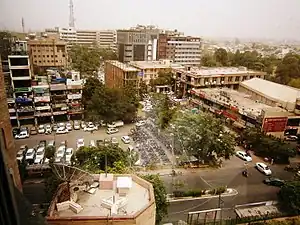
The Auto rickshaw is a three-wheel drive vehicle, which is one way to travel in the city. They have the capacity to hold three to six passengers. It can be hired individually or on a sharing basis. The auto rickshaws are easily available at every major place, including the interstate bus terminal and the railway station at a nominal fare which varies from ₨ 10 to ₨ 30. Jugnoo, an on demand auto rickshaw application launched its operations in February 2015 to provide low cost, reliable, 24×7 service to the citizens of Ludhiana.
Rickshaw
Cycle rickshaws are widely used in Ludhiana. The rickshaw or tricycle is pulled by a person and is a relatively cheap way of travelling in the city, but has become pricey after the autos have been scrapped.
Education
Schools
Ludhiana has 363 senior secondary, 367 high, 324 middle, 1129 primary, and pre-primary recognised Schools, with a total of 398,770 students.[60] Most of these schools are either run by the ICSE Central Board of Secondary Education or by Punjab School Education Board..[61] Prominent schools in Ludhiana includes R.S. Model Senior Secondary School[62] and Wylie Memorial High School.
Agriculture
Ludhiana is home to the largest agricultural university in Asia and one of the largest in the world, Punjab Agricultural University.[63] The College of Veterinary Sciences at PAU was recently upgraded to the Guru Angad Dev Veterinary and Animal Sciences University (GADVASU).
GADVASU was established at Ludhiana by an act of the Punjab Legislature No. 16 of 2005 notified in the Punjab Government Gazette on 9 August 2005 and it started functioning 21 April 2006 for promoting livestock production, health and prevention of disease through integrated teaching, research and extension programmes.[64]
Medical
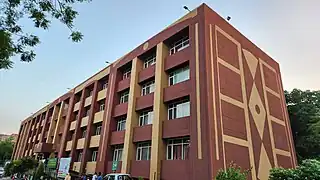
Christian Medical College, Ludhiana, the first medical school for women in Asia, was founded by Dame Edith Mary Brown in 1894. Christian Medical College is a major and reputed tertiary care hospital in India, also the location of the world's first face transplant. Dayanand Medical College and Hospital is another tertiary care teaching hospital in Ludhiana. Both these institutions are recognised by the Medical Council of India. The college is affiliated to Baba Farid University of Health Sciences, Punjab.[65]
Engineering
Guru Nanak Dev Engineering College is an institution offering facilities and education for engineering students. It has a research and development center for bicycles and sewing machines.[66]
Ludhiana College of Engineering and Technology is an institute for Engineering and Management studies.
Notable individuals
- J. C. Mahindra, Indian industrialist and co-founder of Mahindra & Mahindra
- K.C. Mahindra Indian industrialist who co-founded Mahindra & Mahindra
- Sukhdev Thapar, Freedom fighter
- Kartar Singh Sarabha, Freedom fighter
- Gippy Grewal, Singer, actor
- Sukh Sanghera, Film director and music video director
- Bhai Randhir Singh, Freedom fighter
- Neel Kamal Puri, novelist, columnist[67]
- Dharmendra, actor
- Sunil Mittal, entrepreneur, founder of Airtel and Bharti Enterprises
- Simarjit Singh Bains, Social worker, politician
- Sahir Ludhianvi, lyricist
- Sukhdeep Singh Chakria, Boxer
- Divya Dutta, actress
- Manjit Rupowalia, Singer
- Rajinder Gupta, Industrialist, Chairman of TridentGroup
- Trishneet Arora, Ethical hacker, author
- Shubha Phutela, actress
- Dakssh Ajit Singh, actor
- Jainti Dass Saggar, Physician, politician
- Abhinav Shukla, actor
- Sudarshan Agarwal, politician
- Shilpi Sharma, actress
- Gulzar Singh Sandhu, writer
- Naina Dhaliwal, Indian model
- Inderjit Hasanpuri, songwriter
- Ram Singh, Social reformer
- Maulana Habib-ur-Rehman Ludhianvi, One of the founders of Majlis-e-Ahrar-e-Islam
- Barkat Ali Ludhianwi, Muslim Sufi and founder of the Dar ul Ehsan organisation
- Talish, Pakistani actor
- Raj Khosla, director
- Baldev Raj Chopra, producer and director
- Kuldeep Manak, Singer
- Inderjit Nikku, Singer
- Ravinder Grewal, Singer
- Amar Singh Chamkila, Singer
- Surinder Shinda, Singer
- Karnail Gill, Singer
- Ishmeet Singh, Singer
- Lal Chand Yamla Jatt, Singer
- Mandeep Singh, Cricketer
- Pankaj Kapoor, actor
- Hardev Dilgir, lyricist
- Saadat Hasan Manto, writer, playwright
- Sanjeev Talwar, MLA Ludhiana East
- Bharat Bhushan Ashu, MLA Ludhiana West, Punjab Cabinet Minister
- Ish Sodhi, New Zealand Cricketer
- Happy Raikoti, lyricist, singer
- Chetan Sharma, Indian cricket player
- Yashpal Sharma, Indian cricket player
- Jaswinder Bhalla, actor in Punjabi cinema[68]
- Anuv Jain, singer and songwriter
- Anand Arnold, bodybuilder
- Balbir Singh Rajewal, Farm union leader and politician
- Chahat Goyal, software development engineer, Amazon Web Services
- Bhavish Aggarwal, Businessman and Founder of Ola cabs and Ola Electric
- Prabhsukhan Singh Gill, Footballer who plays as a goalkeeper for Kerala Blasters and India national team
See also
Notes
- 1891-1941: Data for the entirety of the town of Ludhiana, which included Ludhiana Municipality, Ludhiana Cantonment, and Ludhiana Civil Lines.[32]: 32
- 1931-1941: Including Ad-Dharmis
References
- "Metropolitan Cities of India" (PDF). cpcb.nic.in. Archived from the original (PDF) on 23 September 2015. Retrieved 22 December 2020.
- "Who's Who | District Ludhiana, Government of Punjab | India". ludhiana.nic.in. Archived from the original on 28 September 2022. Retrieved 8 July 2022.
- Bhardwaj, Nidhi (26 March 2018). "Balkar sandhu becomes mayor of Ludhiana | Ludhiana News - Times of India". The Times of India. Archived from the original on 28 August 2019. Retrieved 14 August 2019.
- "Ludhiana City". Archived from the original on 12 August 2020. Retrieved 20 November 2020.
- "Smart City Ludhiana" (PDF). Archived (PDF) from the original on 27 March 2020. Retrieved 20 November 2020.
- "History". District Ludhiana, Government of Punjab, India. Archived from the original on 23 May 2022. Retrieved 11 June 2022.
- "Area and Population". Official Website of Ludhiana. Archived from the original on 7 March 2016. Retrieved 4 March 2016.
- "United Nations HDI report - Punjab". in.undp.org. 9 March 2012. Archived from the original on 16 October 2021. Retrieved 20 February 2021.
- 164.100.161.224 http://164.100.161.224 Archived 14 August 2023 at the Wayback Machine › filesPDF Ludhiana State: Punjab Category: Business & Industrial Centre, Tier 2 1 ...
- ":: Ludhiana_Municipal_Corporation ::". mcludhiana.gov.in. Archived from the original on 7 January 2022. Retrieved 3 November 2021.
- "India's Manchester". BBC. 28 February 2006. Archived from the original on 18 August 2014. Retrieved 25 May 2014.
- XIM University https://shs.xim.edu.in Archived 23 March 2023 at the Wayback Machine › uploadsPDF LUDHIANA
- "Ludhiana | India | Britannica". Archived from the original on 27 October 2020. Retrieved 23 July 2020.
- "City 48 in Smart City rankings". Tribune. 15 March 2020. Archived from the original on 4 April 2023. Retrieved 10 April 2022.
- "Ludhiana". Encyclopaedia Britannica. Archived from the original on 27 October 2020. Retrieved 23 July 2020.
- "History". Ludhiana. Government of Punjab. Archived from the original on 19 October 2020. Retrieved 23 July 2020.
- Jain, Ananya (31 December 2019). "Ripe with history, Ludhiana's Lodhi Fort lies forgotten without ASI protection". The Indian Express. Archived from the original on 23 July 2020. Retrieved 23 July 2020.
- J.J. Lucas, "Literary Work of the American Presbyterian Mission, North India, Including Bible TranslatioLun and Revision, and Circulation of Religious Books and Tracts," Indian Evangelical Review 13 (July 1886): 43-63.
- "Falling Rain Genomics, Inc – Ludhiana". fallingrain.com. Archived from the original on 29 May 2008. Retrieved 8 June 2008.
- Majeed, Shariq (26 March 2014). "Ludhiana worries over its PM". The Times of India. Archived from the original on 27 March 2014.
- Preet, Jatinder (16 October 2011). "Ludhiana fourth most polluted city in the world". The Sunday Guardian. Delhi, India. Archived from the original on 12 April 2014.
- "How air and water pollution plagues Indian cities". Hindustan Times. 1 December 2013. Archived from the original on 29 January 2014.
- "Station: Ludhiana Climatological Table 1981–2010" (PDF). Climatological Normals 1981–2010. India Meteorological Department. January 2015. pp. 449–452. Archived from the original (PDF) on 5 February 2020. Retrieved 20 January 2021.
- "Extremes of Temperature & Rainfall for Indian Stations (Up to 2012)" (PDF). India Meteorological Department. December 2016. p. M171. Archived from the original (PDF) on 5 February 2020. Retrieved 20 January 2021.
- "Climate & Weather Averages in Ludhiana, Punjab, India". Time and Date. Retrieved 22 July 2022.
- "Climate and monthly weather forecast Ludhiana, India". Weather Atlas. Retrieved 14 June 2022.
- "Station: Ludhiana Climatological Table 1981–2010" (PDF). Climatological Normals 1981–2010. India Meteorological Department. January 2015. pp. 449–452. Archived from the original (PDF) on 5 February 2020. Retrieved 20 January 2021.
- "Extremes of Temperature & Rainfall for Indian Stations (Up to 2012)" (PDF). India Meteorological Department. December 2016. p. M171. Archived from the original (PDF) on 5 February 2020. Retrieved 20 January 2021.
- "Urban Agglomerations/Cities having population 1 lakh and above" (PDF). Provisional Population Totals, Census of India 2011. Archived (PDF) from the original on 2 April 2013. Retrieved 7 July 2012.
- "Table C-01 Population by Religious Community: Punjab". censusindia.gov.in. Registrar General and Census Commissioner of India. Archived from the original on 14 March 2023. Retrieved 18 January 2023.
- "C-1 Population By Religious Community - Ludhiana (M. Corp)". Archived from the original on 23 September 2015. Retrieved 2 December 2019.
- "CENSUS OF INDIA, 1941 VOLUME VI PUNJAB". Archived from the original on 31 May 2022. Retrieved 17 January 2023.
- Virdee, Pippa (February 2018). From the Ashes of 1947. Cambridge University Press. p. 138. ISBN 978-1-108-42811-8. Archived from the original on 14 August 2023. Retrieved 10 January 2020.
- "CENSUS OF INDIA, 1891 GENERAL TABLES BRITISH PROVINCES AND FEUDATORY STATES VOL I". Archived from the original on 17 January 2023. Retrieved 17 January 2023.
- "CENSUS OF INDIA, 1901 VOLUME I-A INDIA PART II-TABLES". Archived from the original on 17 January 2023. Retrieved 17 January 2023.
- "CENSUS OF INDIA, 1911 VOLUME XIV PUNJAB PART II TABLES". Archived from the original on 21 July 2022. Retrieved 17 January 2023.
- "CENSUS OF INDIA, 1921 VOLUME XV PUNJAB AND DELHI PART II TABLES". Archived from the original on 17 January 2023. Retrieved 17 January 2023.
- "CENSUS OF INDIA, 1931 VOLUME XVII PUNJAB PART II TABLES". Archived from the original on 17 January 2023. Retrieved 17 January 2023.
- https://censusindia.gov.in/nada/index.php/catalog/10229/download/13341/DDW-C16-TOWN-STMT-MDDS-0300.XLSX Archived 23 March 2023 at the Wayback Machine
- "Cow cess runs in crores, but stray-cattle menace continues in Ludhiana". Hindustan Times. 23 July 2021. Archived from the original on 23 February 2022. Retrieved 23 February 2022.
- "Electors and Polling Stations - VS 2017" (PDF). Archived (PDF) from the original on 10 January 2020. Retrieved 24 June 2021.
- "List of Parliamentary Constituencies and Assembly Constituencies in the State of Punjab as determined by the delimitation of Parliamentary and Assembly Constituency notification dated 19th June, 2006". 19 June 2006. Archived from the original on 26 June 2021. Retrieved 24 June 2021.
- "Doing Business in India 2009". World Bank. Archived from the original on 7 October 2010. Retrieved 8 June 2010.
- Entrepreneurship in India's small-scale industries. Richard P. Taub, Doris L. Taub
- Staff. "Ludhiana Portal Digital directories & Newspapers". City Vibes. Archived from the original on 15 December 2018. Retrieved 12 December 2018.
- "Punjab industry gives thumbs down to Arun Jaitley's Union Budget". Hindustan Times. 1 February 2018. Archived from the original on 5 December 2018. Retrieved 12 December 2018.
- "BizMerlinHR Named a Cool Vendor in the 2021 Gartner 'Cool Vendors in Human Capital Management: Technology Innovations to Support the Future of Work' Report". BizMerlinHR. 30 April 2021. Archived from the original on 19 May 2021. Retrieved 19 May 2021.
- "District Sports Office | District Ludhiana, Government of Punjab | India". ludhiana.nic.in. Archived from the original on 24 November 2021. Retrieved 24 November 2021.
- "Kabaddi World Cup: India all the way". The Tribune – Sports Page. 21 November 2011. Archived from the original on 23 February 2012. Retrieved 10 June 2012.
- Sharma, Nitin (12 December 2016). "Chandigarh's Minerva Football Club inducted into AIFF league". The Indian Express. Archived from the original on 24 November 2021. Retrieved 24 November 2021.
- "Racy start to Kila Raipur Rural Olympics". The Tribune – Ludhiana Tribune. 4 February 2011. Archived from the original on 17 June 2012. Retrieved 10 June 2012.
- "Leisure Valley rink hosts roller-skating competition". Tribuneindia News Service. 15 March 2018. Archived from the original on 17 May 2022. Retrieved 9 September 2020.
- "Ludhiana to Kolkata". Archived from the original on 10 March 2014. Retrieved 22 March 2021.
- "State Highways in Punjab". PWD - Govt. of Punjab, India. Archived from the original on 25 May 2018. Retrieved 25 May 2018.
- "National Highways in Punjab". PWD - Govt. of Punjab. Archived from the original on 25 May 2018. Retrieved 25 May 2018.
- http://www.aai.aero/allAirports/ludhiana.jsp Archived 24 March 2013 at the Wayback Machine Airport website
- "Delhi-Katra Vande Bharat Express: Fare, timings, features, other details". Livemint. 29 September 2019. Archived from the original on 13 February 2020. Retrieved 13 February 2020.
- "Ola Cabs launch in Ludhiana and Amritsar". Archived from the original on 30 October 2014.
- Ltd., Zoomcar India Private. "Self Drive Cars in Ludhiana". Zoomcar. Archived from the original on 15 September 2017. Retrieved 15 September 2017.
- "Education and Medical Facilities - Official Website of Ludhiana". Archived from the original on 22 December 2015.
- Staff. "Digital directories & Newspapers". City Vibes. Archived from the original on 1 November 2018. Retrieved 1 November 2018.
- Kumar, Aneesha Sareen (12 May 2021). "Govt-aided school in Ludhiana opens for teachers in violation of curfew orders". Hindustan Times. Archived from the original on 11 April 2022. Retrieved 11 April 2022.
- "Ludhiana Colleges". Mapsofindia.com. Archived from the original on 2 December 2011. Retrieved 16 June 2014.
- "GADVASU CET 2017 Second Counseling Results Declared on gadvasu.in". News18. 17 August 2017. Archived from the original on 11 April 2022. Retrieved 11 April 2022.
- "BFUHS Affiliations". bfuhs.ac.in. Archived from the original on 15 July 2023. Retrieved 15 July 2023.
- "www.bsrdindia.com". Archived from the original on 1 August 2015. Retrieved 27 July 2015.
- "Punjab's victory over history". India Today. 4 March 2013. Archived from the original on 14 September 2014. Retrieved 28 July 2015.
- Kapoor, Diksha (4 May 2020). "Happy Birthday Jaswinder Bhalla! Watch His 5 Best Comedy Films To Drive Away Your Monday Blues". PTC Punjabi. Archived from the original on 11 November 2020. Retrieved 11 November 2020.
Bibliography
- Mahan Kosh, Bhai Kahan Singh Nabha, pp 311.
- Encyclopaedia of Sikhism, Prof. Harbans Singh vol 2 pp 416
- The Sikh Ref Book, Dr Harjinder Singh Dilgeer p464 & p196
- "Hazrat Shah Kamal Qadri Kaithaly". shah-kamal.com.
- Pankaj Mishra (1 January 1995). Butter chicken in Ludhiana: travels in small town India. Penguin Books. ISBN 9780140250671.
- "Heavy metal contamination of the ecosystems by industrial emissions from Ludhiana"
